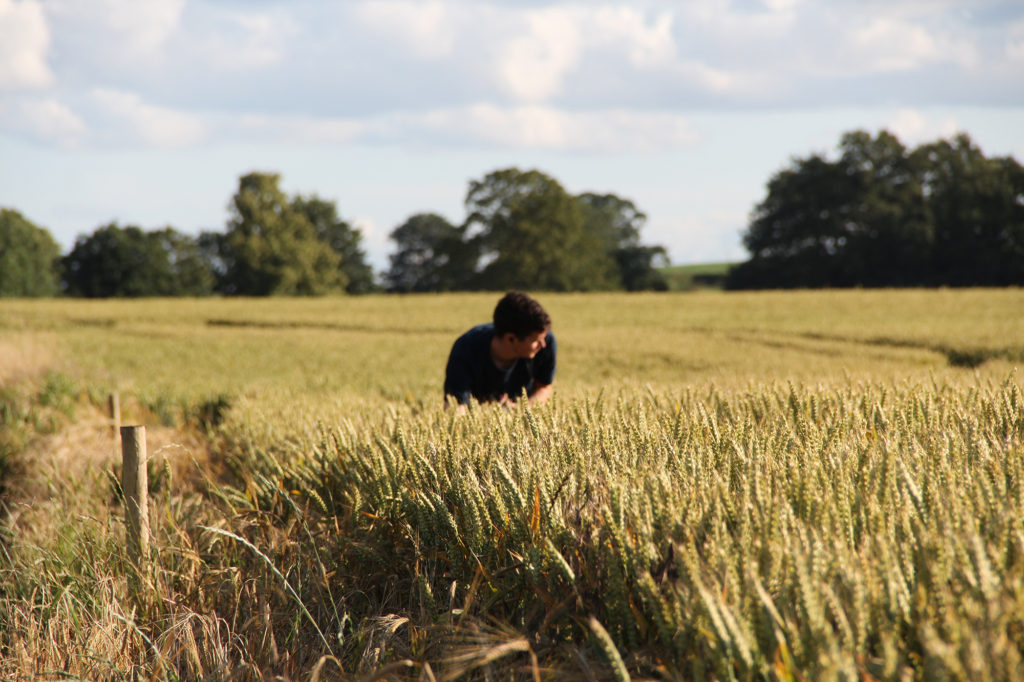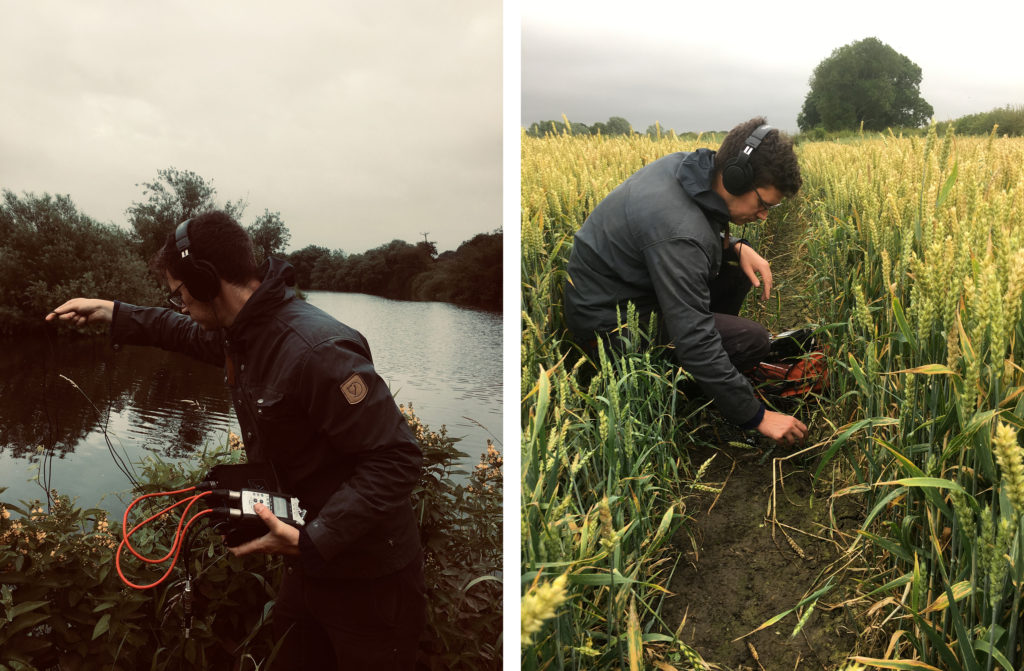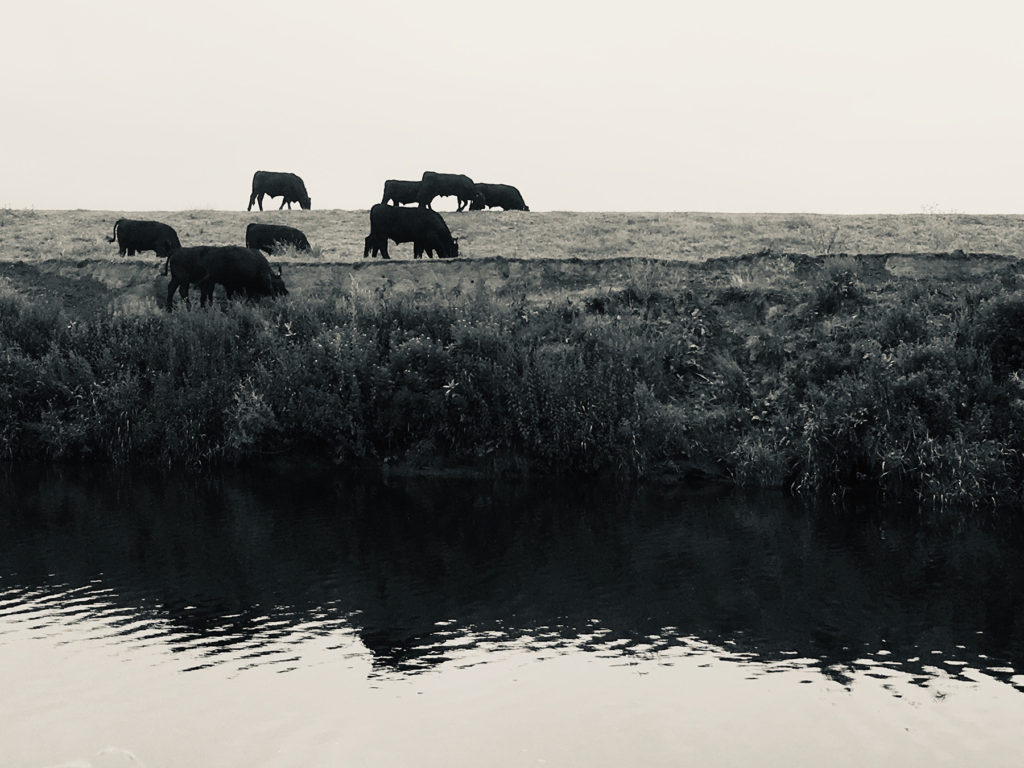Sub-surface sound

Rob:
We’ve just finished another few days of collaborative fieldwork at Aldborough under cloudbursts of summer rain. We collected what are probably the final sound recordings for the project from the village landscape, ahead of their transformation into the sound work for the installation, sound trail and book.
In a barley field just north of the village we tiptoed along tractor tracks, eyes scanning the sticky alluvial ground for a small borehole. A month or so ago, Rose and her geo-archaeology collaborators cored a series of boreholes into the ground in this area to investigate the course of an ancient river channel. In Roman times, this palaeo-channel would still be evident in the landscape, seasonally flooding and full of the calls and wingbeats of wetland birds. Now the area is arable farmland behind flood defences, where warblers flit through fluttering barley and oilseed rape stems.
The borehole – roughly 5cm wide – extends 6 meters into the ground, and the resulting core allows Rose and her collaborators to understand the layers of material laid down by the old river channel, and accordingly how this landscape has changed through time. A combination of the high water table and the recent heavy rain meant that there was standing water in the borehole, its glimmering surface just visible from the top.
So the first thing I did was lower a hydrophone – or underwater microphone – down the borehole to see what we could hear. The answer? Nothing, really. The water was still and devoid of any life (or at least life that emits underwater sounds…) So I had another idea. I have a microphone – the mikroUši Pro – which is incredibly good at recording quiet and delicate sounds. It looks a little like a device you’d imagine a spy feeding through a hole in a hotel wall to eavesdrop on a mark – with a tiny head connected to a long, thin wire.
Suddenly the borehole became a richly-textured acoustic space. Every grain and fragment of the clayey ground trickling down the borehole sides and into the pool of standing water sounded like the tumble of an avalanche. There was a feeling of closeness – claustrophobia even – about listening metres underground: a strange, short echo of every sound, somehow thick and gloopy. Pulling the microphone slowly back up the borehole, you could hear the acoustic space opening out – a difficult thing to describe, but almost like slowly increasing the pitch of the world, the above-ground landscape began to seep back into the recording, along with the rustle of the barley in the wind and the peeping swallows.
We walked along the raised flood banks along the river to the site of an old quay, now lost under the towering stems of Himalayan balsam and giant hogweed on the river bank. We lowered a pair of hydrophones into the river, amongst the trailing branches of a weeping willow tree. We could hear the gloop of air bubbles rising from the same alluvial sediment we’d cored through in the barley field borehole, and the sound of aquatic insects calling. One prominent insect sounded like a thumb run quickly across the teeth of a comb; or perhaps like a mini avalanche of grains of material.
Listening underground and underwater are two ways we’ve chosen to explore Aldborough’s sub-surface landscape, and these approaches have provided us with lots of rich material and experiences for thinking through the site’s history. However, we’ve also thought about the sub-surface of materials in the landscape. How do the characteristics of different objects variously transmit and resonate with sound, and how might listening to this influence how we hear and interpret the landscape? How might recording sited (but often abstract) recordings from materials in the landscape give me the compositional clay to try and evoke the history of different sites through Aldborough?
Just as at the dig in May, we used contact mics and woodworking clips to listen in to a variety of materials and objects. At the old Roman quarry, shards of glass and metal became percussive instruments in the heavy rain, as the sound of cars on the wet road above washed over like waves. Tall hollow Himalayan balsam stems echoed and wobbled in the wind, as the rain plopped onto leaves and ran down the centre of the stem: another type of resonant borehole.
On the flood defences, a metal gate creaked like a John Cale viola drone. I had heard this creak echo across the landscape on each previous visit, but been put off from recording it by the steady stream of dog walkers and runners using the river-side path. Rose and I walked the route in the evening gloam, attaching contact mics to the gate and its housing; hearing a rich and surprising range of tones and textures from the movement of the metal, and also sounds from the landscape resonating through it. The evening song of thrushes and warblers transmitted through metal; the gate an ‘antenna’ for the wider landscape; everything seeping into everything.

Rose:
Archaeology is so often about feel. The feel of soils and sediments through trowel or mattock, the feel of a particular material to identify a find: pot, bone, stone. But it is also about sensing the unseen, of having a feel for data and in all its abstract forms. It is a process of fine tuning your senses to a particular site, landscape or mode of working.
In doing geophysics, I’ve become attuned to the magnetic responses of the ground. What appears to be a normal field on the surface has the potential to be brimming with activity below ground, and this invisible world can be seen through the lens of its magnetic response, captured by a machine. The capturing is a strange sort of process really; pretty abstract. We walk over fields in strict grids and lines, pacing to a series of timed beeps, the machine clicking away collecting data. It is only when it is downloaded that we are able to see the visual outcome of this strange exercise: a monochrome set of arranged pixels. Yet once you get a feel for them, these images hold rich threads of narratives, glimpses of sequences and time passing. I’ve carried out these surveys in all sorts of strange places: edgelands, inlands, outlands, archaeology seeps back into the present in digital form, ripe for exploration.
What fascinates me is the way that over time, these objective monochrome outputs sing with, not only hypothesised narrative and the naming of features – ‘town house’ ‘street’ ‘collonade’ – but with texture, and material memory. The feel of different silty sands and sandy silts, of grits and cobbles, chalk and machair when excavating, becomes part of our very particular learnt anthology of archaeological textures. These translate back onto the monochrome cartographies of magnetometry survey imagery, animating them in my imagination into sturdy, gritty, flumpy, chunky structures and stratified deposits.
As Rob and I went exploring with his sound toolkit last week, a similar sense of material intimacy began to emerge. By attaching microphones to different objects and materials, we were suddenly granted access to an invisible – and normally inaudible – world. When contact mics were attached to a very ordinary stem of Himilayan Balsalm (which crowds the quarry floor at this time of year), a hollow, active world emerged. With the headphones on, this became more than the sum of its parts: the sound gave a new sense of space, opening out to a wider plant world. We were hearing the rain soaked heartbeat of the plant. With the headphones off, it vanished, as if by magic; and the woods seemed quiet, private again.
These soundings echoed the sub-surface imagination of geophysics for me in other ways too. Standing down by the river, Rob dangled hydrophones into the rippling eddies. I watched him for a while, looking out and thinking about those ancient channels, listening to the swallows race by. Then, headphones on: hummmmmmmm tick tick brrrrrrrrrrrrrrrr tick mmmmmmm tick pt pt pt. Signals from the water, the beat of the river changing as water life drifted into the pick-up zone of the microphone. An invisible, busy life occurring under the surface of the water. We hovered on the bank trying to interpret and imagine the scene beneath.
And this was just one type of signal, one way of hearing beneath the surface. On the flood plain we crouched in a tractor rut in a wheat field to aurally descend into one of the boreholes taken in May for pollen analysis. Headphones on: shut your eyes and this isn’t a narrow hole, but a descent into the underworld to hear the breath of the earth. Small fragments of soil dropped in were depth charges, reverberating echoes of prehistory. Headphones off: the wheat rustling and a dog walker calling “Reeky! Reeky! Reeky!” away down the lane.

